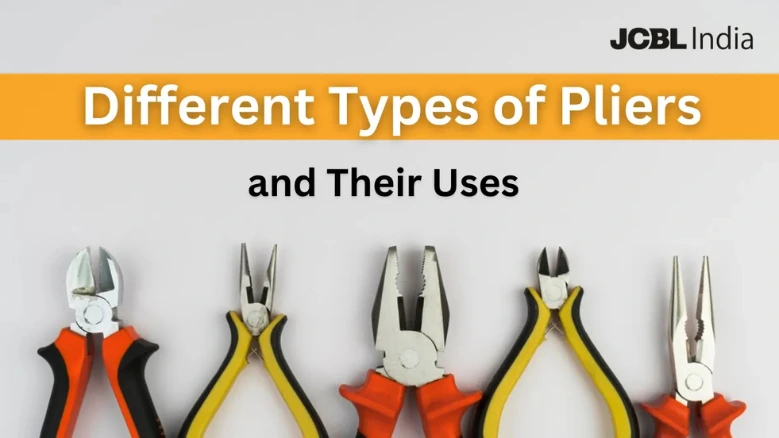What Are Pliers Used For? A Complete Guide

You might have seen pliers in your toolbox. It is a hand-operated tool that consists of three parts head or jaw, pivot, and handles. A plier has hard metal parts at one end and two handles to hold on the other. Further, the formation of two levers of pliers in such a way that they can hold objects securely when exerting opposite force. Pliers are based on the “law of lever“. Thus, it enables you to exert greater force on the object. The force you can apply on an object depends on the distance between two handles. Confused about what pliers are used for. Let’s learn about the uses of pliers with JCBL Hand Tools –
Do you know, it can do more than just gripping and twisting objects? Pliers come in handy for students in DIY activities, as well as for professionals. You can perform various tasks using pliers like cutting, bending, attaching, detaching, holding, turning, etc. Many industry professionals use them like mechanics, jewelers, electricians, plumbers, etc. It is important to use the right type of plier so that you don’t cause any damage to the object. There are many types of pliers available in the market, thus finding the right one is difficult. Now, let’s learn about the uses of different types of pliers-
Uses of different types of pliers
Pliers have different uses depending on the features of their jaws. For example, some types of pliers have an adjustable joint that can provide more leverage. In addition, some pliers are versatile for a variety of tasks, whereas some are not. Let’s clear out the confusion by understanding the uses of different types of pliers:
What are slip joint pliers used for
Slip joint pliers are multipurpose pliers making it an all-rounder tool in the field of hand tools. They have adjustable pivot joints. This further allows the grip to be adjusted based on the size of the object. Further, their ability to adjust makes them versatile. You can find out whether slop joint pliers are for your use or not by understanding the following pros and cons-
Pros
- Have many use cases like cutting, gripping, bending, crimping, etc.
- Suitable for DIY, as well as professional use.
- Offers strength and adjustability.
- Adjustable pivot point, thus allowing to adjust jaw for objects of various sizes.
Cons
- Not suitable for objects that need to be held tightly.
- Might slip out of hand because of its dull teeth.
- Handles might wobble at the pivot point.
What are snap ring pliers used for
The primary application area of snap ring pliers is to install and remove the circlips or snap rings. These are specially designed to manipulate the snap rings. Also, securing the components in advanced machinery and equipment is another area of use for such types of pliers. There are different types of snap ring pliers available in the market. Some of its types include inner, outer, heavy-duty, loose-nose snap ring pliers, etc. To ease their use, you need to understand their pros and cons-
Pros
- Allows installation, removal, and manipulation of pliers.
- Provide better control and precision in securing, as well as removing snap rings in machines.
- Able to handle tough and large snap rings
- Offers flexibility in the limited spaces.
Cons
- Designed for specific use.
- Lack of versatility.
- Needs mastery to use snap ring pliers.
What are locking pliers used for
Locking pliers have lock functioning. This allows you to hold, turn, and clamp the object with a tight grip in the locked position. In addition, they are suitable for loosening the bolts with a stripped head. Vise-grips or mole-grips are some other names for locking pliers. They come in different sizes and styles like clamps, wrenches, and needle nose pliers. Furthermore, locking pliers is a good choice for welding. They also have many pros and cons-
Pros
- Offer tight and strong grip, thus when locked it stays in the same position.
- Versatile for different tasks.
- Suitable in cases with stripped or stuck bolts, also where bolts need to be removed.
Cons
- Locking mechanisms might wear out thus reducing their effectiveness.
- Large and bulky in size.
What are needle nose pliers used for
Needle nose pliers are used in tasks where high levels of precision and detail are needed. Its primary uses are repositioning, snipping, and bending. Also, their thin jaws make them feasible for use in tight spaces. Thus, they are known as long-nose pliers. They are suitable for tasks involving the use of wires like electricity and project work. They also have many pros and cons:
Pros
- Offers precision, thus suitable for tasks requiring a high level of detail.
- Ideal for small spaces.
- Versatile for a wide range of tasks.
Cons
- Can break easily as they are not tough and strong enough to handle too much force
- Not suitable for heavy-duty work.
What are cutting pliers used for
The primary use of cutting pliers is to cut nails, wires, and other materials. They have sharp edges on the sides near the pivot to cut the tough materials. Jewelers, electricians, and technicians also use them to cut different types of metals. Further, they have many pros and cons-
Pros
- Have sharp cutting edges, thus efficient for cutting wires and other materials.
- Highly durable due to their special design to cut and handle tough materials.
- Versatile for different tasks ranging from jewelry to electricity tasks.
Cons
- Not feasible for tasks like gripping, bending, and twisting.
- Efficiency reduces over time, thus they need regular maintenance
What are water pump pliers used for
Water pump pliers contain multiple adjustment positions. They are also known as groove joint pliers or tongue pliers. Their multiple adjustment position makes them suitable for plumbing purposes. Just like other types of pliers, they also have pros and cons-
Pros
- Multiple adjustments make them highly versatile.
- Good choice for repair in the plumbing and automotive field.
- Provide a strong and secure grasp.
Cons
- Need proper adjustment.
- difficult to handle.
- Heavy and bulky in size.
- Not suitable for delicate tasks.
Conclusion
In conclusion, pliers have many use cases than just gripping and twisting objects. They come in handy in a variety of tasks in households, plumbing, electricity, construction, etc. Also, each type of plier is designed for a specific task. Thus, understanding their uses, pros, and cons is important, so that you can choose the right one for your needs.
Get yourself pliers to your needs at JCBL Hand Tools. We have years of experience in manufacturing a variety of hand tools that meet international quality standards. Click here to check out our product range of hand tools and complete your toolbox.
FAQ
What are pliers?
Pliers are hand tools. It has three parts- jaw, pivot, and handles. Their design makes them suitable for a variety of tasks like gripping, cutting, bending, or holding. Professionals are not the only ones who use pliers, they also have use cases in households and school projects.
What are tongue and groove pliers used for?
The primary purpose of tongue and groove pliers is to turn and hold nuts and bolds. Clamping materials and gripping the objects tightly in one position are also some of their uses.
What are the types of pliers?
There are different types of pliers like lock grip, combination pliers, cutting pliers, long nose, water pump, slip tongue, snap clip, fence pliers, etc.




